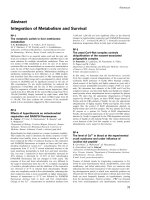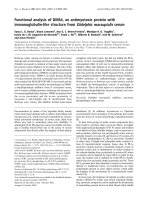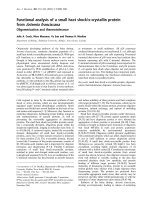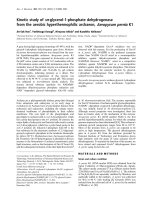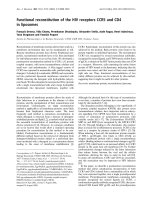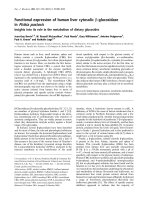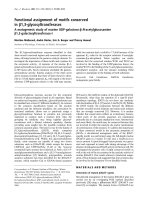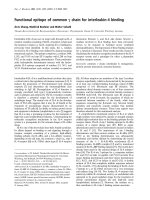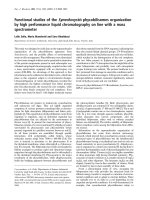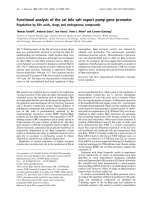Báo cáo Y học: Functional integration of mitochondrial and hydrogenosomal ADP/ATP carriers in the Escherichia coli membrane reveals different biochemical characteristics for plants, mammals and anaerobic chytrids pdf
Bạn đang xem bản rút gọn của tài liệu. Xem và tải ngay bản đầy đủ của tài liệu tại đây (267.61 KB, 10 trang )
Functional integration of mitochondrial and hydrogenosomal ADP/ATP
carriers in the
Escherichia coli
membrane reveals different biochemical
characteristics for plants, mammals and anaerobic chytrids
Ilka Haferkamp
1
, Johannes H. P. Hackstein
2
, Frank G. J. Voncken
2
, Guillaume Schmit
1
and Joachim Tjaden
1
1
Pflanzenphysiologie, Universita
¨
t Kaiserslautern, Germany;
2
Department of Evolutionary Microbiology, Faculty of Science,
Catholic University of Nijmegen, the Netherlands
The expression of mitochondrial and hydrogenosomal
ADP/ATP carriers (AACs) from plants, rat and the
anaerobic chytridiomycete fungus Neocallimastix spec. L2
in Escherichia coli allows a functional integration of the
recombinant proteins into the bacterial cytoplasmic
membrane. For AAC1 and AAC2 from rat, apparent
K
m
values of about 40 l
M
for ADP, and 105 l
M
or
140 l
M
, respectively, for ATP have been determined,
similar to the data reported for isolated rat mitochon-
dria. The apparent K
m
for ATP decreased up to 10-fold
in the presence of the protonophore m-chlorocarbonyl-
cyanide phenylhydrazone (CCCP). The hydrogenosomal
AAC isolated from the chytrid fungus Neocallimastix
spec. L2 exhibited the same characteristics, but the
affinities for ADP (165 l
M
)andATP(2.33m
M
)were
significantly lower. Notably, AAC1-3 from Arabidopsis
thaliana and AAC1 from Solanum tuberosum (potato)
showed significantly higher external affinities for both
nucleotides (10–22 l
M
); they were only slightly influenced
by CCCP.
Studies on intact plant mitochondria confirmed these
observations. Back exchange experiments with preloaded
E. coli cells expressing AACs indicate a preferential export
of ATP for all AACs tested. This is the first report of a
functional integration of proteins belonging to the mito-
chondrial carrier family (MCF) into a bacterial cytoplasmic
membrane. The technique described here provides a relat-
ively simple and highly reproducible method for functional
studies of individual mitochondrial-type carrier proteins
from organisms that do not allow the application of
sophisticated genetic techniques.
Keywords: ADP/ ATP carriers; mitochondria; hydrogeno-
somes; heterologous expression; Escherichia coli.
A high degree of compartmentalization is characteristic of
eukaryotic cells. The transport of metabolic intermediates
between organelles is necessary for complex metabolism and
is mediated by membrane proteins which function as
carriers or channels. Mitochondria and certain hydrogeno-
somes evolved peculiar ADP/ATP carriers (AACs) that
efficiently export ATP, whereas plastids acquired a different
type of nucleotide transporter that seems to be specialized in
ATP uptake [1–3].
In many multicellular animals and plants as well as in
yeast (Saccharomyces cerevisiae),twotofourAACisoforms
have been identified [4–8]. Mammalian AACs seem to have
a tissue specific expression [4–6,9], whereas in yeast, the
expression of the various isoforms is believed to be
characteristic for certain metabolic states, or to participate
in vacuolar metabolism [10,11]. However, the reasons for
the repeated evolution of AAC isoforms and the intrinsic
biochemical differences between the various isoforms
remained largely unknown until now.
Isolated mitochondria of plants and mammals are likely
to represent a mixture of mitochondrial variants that
possess different isoforms of AACs. Consequently, a
biochemical characterization of the various isoforms of
AACs is difficult, if not impossible using conventional
methods of cell fractionation. The function of the different
AACs in S. cerevisiae could be studied taking advantage of
the sophisticated genetic tools available for this organism:
deletion mutants for all three isoforms have been generated
that allowed a detailed analysis of particular AACs in the
absence of other isoforms [10,11]. Trivially, comparable
studies are only possible in organisms with a highly
developed Ôgenetic tool kitÕ (cf. Drosophila [12]). Therefore,
alternative methods are required to study particular iso-
forms of mitochondrial-type AACs in organisms that do
not allow the application of sophisticated genetic tech-
niques. The aim of the present study is the development of a
simple and reproducible approach to analyse the biochemi-
cal properties [substrate affinities, proton motive force
(PMF) dependency] of individual mitochondrial-type AACs
in order to identify differences in the function of the various
isoforms and to understand the repeated evolution of AAC
isoforms in a variety of organisms.
We have shown earlier that it is possible to express
adenine nucleotide transporters of plastids and certain
parasites, i.e. Chlamydia and Rickettsia, in Escherichia coli
and to test their function in vivo [13–16]. This technique
Correspondence to J. Tjaden, Pflanzenphysiologie, Universita
¨
t
Kaiserslautern, Erwin-Schro
¨
dinger-Str., D-67663 Kaiserslautern.
Fax: + 631 2052600, Tel.: + 631 2052505,
E-mail:
Abbreviations: AAC, ADP/ATP carrier; CCCP, m-chlorocarbonyl-
cyanide phenylhydrazone; IPTG, isopropyl thio-b-
D
-galactoside;
MCF, mitochondrial carrier family; PMF, proton motive force.
(Received 13 February 2002, revised 29 April 2002,
accepted 9 May 2002)
Eur. J. Biochem. 269, 3172–3181 (2002) Ó FEBS 2002 doi:10.1046/j.1432-1033.2002.02991.x
might be a matter of choice also for other nucleotide
carriers, but recently published data suggested that mito-
chondrial-type AACs might be deposited preferentially as
inclusion bodies in E. coli; for a functional biochemical
analysis these inclusion bodies have to be solubilized and
reconstituted in vitro [17–19]. Here, we describe a technique
that allows the functional expression of a variety of single
mitochondrial-type AACs in E. coli. After IPTG-induction
we were able to obtain functional integration of the various
mitochondrial-type AACs into the cytoplasmic membrane
of E. coli. Measuring the uptake of the various adenylates
into intact E. coli cells expressing eukaryotic AACs, we were
able to determine the biochemical properties of the different
mitochondrial-type AACs. We studied two AAC isoforms
from rat (Rattus norwegicus) and a mitochondrial-type
AAC from the hydrogenosomes of the anaerobic chytrid
Neocallimastix. As the knowledge about plant mitochon-
drial nucleotide exchange is so far quite limited, we
investigated three AAC isoforms from Arabidopsis thaliana
and one AAC from potato (Solanum tuberosum). The
results obtained by expression in E. coli were justified by
comparison with the adenylate uptake into intact plant
mitochondria isolated from Arabidopsis and Solanum leaves
or potato tubers, respectively.
EXPERIMENTAL PROCEDURES
DNA constructs for heterologous expression of AACs
in
E. coli
DNA manipulations were performed essentially as des-
cribed in Sambrook et al. [20]. The expression plasmids
(pet16b, Novagen, Heidelberg, Germany) encoding the
recombinant AAC proteins with an additional N-terminal
tag of 10 histidine residues were constructed as follows: the
cDNA coding the entire AACs were generated by PCR
from first-strand cDNA of plants and mammals (Arabid-
opsis thaliana, Solanum tuberosum and Rattus norwegicus)or
from a full-length cDNA clone (Neocallimastix spec. L2)
with Pfx DNA polymerase (Gibco BRL, Eggenheim,
Germany), which possesses proof reading activity. Sense
primers incorporating an NdeI restriction site and antisense
primers were used for the PCR reaction (Table 1). The
obtained PCR products were purified (QIAquick PCR
Purification Kit, Qiagen, Hilden, Germany), subcloned into
the EcoRV restriction site of the plasmid pBSK (Stratagene,
Heidelberg, Germany) and checked by sequencing both
strands by chain-termination reaction (MWG-Biotech,
Ebersberg, Germany). For the construction of the E. coli
expression plasmids (encoding His
10
–AAC), the NdeI–XhoI
(NdeI–BamHI or NdeI–BglII) DNA inserts of the pBSK-
plasmids were introduced in-frame into the corresponding
restriction sites of the isopropyl thio-b-
D
-galactoside
(IPTG)-inducible T7-RNA polymerase bacterial expression
vector pet16b (Novagen, Heidelberg, Germany). Transfor-
mations of E. coli were carried out according to standard
protocols. The nucleotide sequences of the AACs reported
in this paper are available under the accession numbers
(EMBL database): AY042814 (aac1, A. thaliana),
AY050857 (aac2, A. thaliana), AL021749/gene ¼
ÔF20O9.60Õ (aac3, A. thaliana), X62123 (aac1, S. tubero-
sum), D12770 (aac1, R. norwegicus), D12771 (aac2,
R. norwegicus), AF340168 (hdgaac, Neocallimastix spec.
L2).
Heterologous expression of AACs in
E. coli
The E. coli strain BL21 (DE3) was used for heterologous
expression. The several cDNAs encoding the correspond-
ing AAC proteins under control of the T7-promoter were
transcribed after IPTG induction of the T7-RNA poly-
merase [21]. E. coli cells transformed with the AAC
expression plasmids (or control expression plasmid
pet16b) were inoculated with a fresh overnight culture
and grown at 37 °CeitherinYT
Amp/Clm
medium (YT:
5gÆL
)1
yeast extract, 8 gÆL
)1
peptone, 2.5 gÆL
)1
NaCl,
pH 7.0; for hydrogenosomal AAC) or in TB
Amp/Clm
medium (TB: 2.5 gÆL
)1
KH
2
PO
4
,12.5gÆL
)1
K
2
HPO
4
,
12 gÆL
)1
peptone, 24 gÆL
)1
yeast extract, 0.4% glycerin,
pH 7.0) supplemented with 10 m
M
malate and 10 m
M
pyruvate (rat and plant AACs) [20]. A D
600
value of
0.5–0.6 was required for the initiation of T7-RNA
polymerase expression by addition of IPTG (final con-
centration 0.012%). Cells were grown for 1 h after
Table 1. Oligonucleotides used for construction of the expression plasmids of plant, mammalian and chytridic AACs. Thelower-caseletterindicates
the introduced base exchange to create restriction sites (NdeIorBglII).
aac Oligonucleotide sequence
aac1 (A.t.) Sense 5¢-TGCAGAGTTCcAtATGGTTGATCAAG-3¢
Antisense 5¢-CGAAAAAAGGAGGAAGAAGCAATGC-3¢
aac2 (A.t.) Sense 5¢-TGTAGAGGTTcAtATGGTTGAACAGACTC-3¢
Antisense 5¢-CTTAATGACTGCGGGATTTGGTGGTAC-3¢
aac3 (A.t.) Sense 5¢-CTGATTTGTACAAcAtATGGATGGATC-3¢
Antisense 5¢-GGGCTATTCTTTCATCATCCTCATCG-3¢
aac1 (S.t.) Sense 5¢-TTAAACGTTcatATGGCAGATATGAACC-3¢
Antisense 5¢-GGAAGTTACGAGGCTGACTTAGGC-3¢
aac1 (R.n.) Sense 5¢-GCGCCCGCGTTTCcatATGGGGGATCAG-3¢
Antisense 5¢-CCACACAATGGATCTGTGAACCTGTG-3¢
aac2 (R.n.) Sense 5¢-CTTTTTTGCTTTCcAtATGACAGATGCCG-3¢
Antisense 5¢-TACAACATGCCAGAtCtCGGGGAGAAC-3¢
hdgaac (N.spec.) Sense 5¢-TTCCCCATATCCcAtATGGCCCAAAAG-3¢
Antisense 5¢-GCATTCGTTTAGTTCTTAATTCTCCAG-3¢
Ó FEBS 2002 Functional integration of AACs in E. coli (Eur. J. Biochem. 269) 3173
induction and collected by centrifugation for 5 min at
5000 g (8 °C, Sorvall RC5B centrifuge, rotor type SS34;
Sorvall-Du Pont, Dreieich, Germany). The sediments were
resuspended to D
600
¼ 5 using potassium phosphate
buffer (50 m
M
, pH 7.0) [16] and stored at 8 °C until use.
Uptake of radioactively labeled ATP and ADP
IPTG-induced E. coli cells (100 lL) harbouring the AAC
expressing plasmids (or the given controls) were added to
100 lL potassium phosphate buffer (50 m
M
,pH7.0)
containing radioactively labeled ATP or ADP. [a-
32
P]
adenine nucleotides were used at specific activities between
100 and 3000 lCiÆlmol
)1
.[a-
32
P]ADP was synthesized
enzymatically from [a-
32
P]ATP (NEN, Bad Homburg,
Germany), as described by Tjaden et al.[13],andthe
purity of the [a-
32
P]ADP preparation was confirmed by a
thin-layer chromatography [13]. Uptake of nucleotides
was carried out at 30 °C in an Eppendorf reaction vessel
incubator and terminated after the indicated time periods
by transferring the cells to a 0.45-lmfilter(25mm
diameter, Orange Scientific, Waterloo, Belgium) under
vacuum previously moistened with potassium phosphate
buffer (50 m
M
, pH 7.0) [22]. Cells were further washed to
remove unimported radioactivity by addition of three
times 4-mL potassium phosphate buffer (50 m
M
,pH7.0).
The filter was subsequently transferred into a 20-mL
scintillation vessel and filled with 10 mL of water.
Radioactivity in the samples was quantified in a
Canberra–Packard Tricarb 2500 scintillation counter
(Canberra–Packard, Frankfurt, Germany). For back
exchange (efflux) experiments, the E. coli cells were
preincubated for 2 min at 30 °C with potassium phos-
phate buffer (50 m
M
, pH 7.0) containing [a-
32
P]ADP or
[a-
32
P]ATP (specific activity 100 lCiÆlmol
)1
). Preloading
was stopped by centrifugation (5000 g, 45 s, room tem-
perature). The washed sediment (four times with potas-
sium phosphate buffer) was subsequently resuspended in
incubation buffer containing the indicated additions and
incubated for 1.5 min at room temperature. The cells were
sedimented for 2 min at room temperature in an eppen-
dorf centrifuge (5000 g). The supernatents were trans-
ferredtonewreactionvesselsandheatedto95°Cfor
10 min to prevent any further reaction. An aliquot of the
exported radioactive solution was used for separation by
thin-layer chromatography [23].
Thin-layer chromatography of radioactively labeled
adenine nucleotides
To identify the type of adenine nucleotide exported from
[a-
32
P]ADP or [a-
32
P]ATP preloaded E. coli cells, we
employed a thin-layer chromatography system according
to the method of Mangold [23]. Radioactively labeled
samples were loaded onto a 0.5-mm poly(ethylene amine)
cellulose thin-layer chromatography plate and dried with a
fan. Separation was carried out for 0.5 min using 0.5
M
sodium formiate (pH 3.4), for 2 min using 2
M
sodium
formiate (pH 3.4) and the front was allowed to run for
15 cm with 4
M
sodium formiate (pH 3.4). R
f
values of
radioactively labeled adenine nucleotides were determined
after autoradiography and correspond to R
f
values of
unlabeled nucleotides visualized under UV light [23].
Radiolabeling of AAC proteins synthesized in
E. coli
and enrichment of the histidine-tagged chimeric proteins
Ten milliliters of E. coli cells harbouring the indicated
plasmids were grown to exponential phase, collected by
centrifugation at D
600
¼ 0.5, and resuspended in 1 mL of a
methionine assay medium containing 42 m
M
Na
2
HPO
4
,
20 m
M
KH
2
PO
4
,18m
M
NH
4
Cl, 8.5 m
M
NaCl, 1 m
M
MgSO
4
,0.1m
M
CaCl
2
,20m
M
glucose, and 0.1 mgÆmL
)1
thiamine (Difco Laboratories, Heidelberg, Germany). T7-
RNA polymerase synthesis was induced by adding 1 m
M
IPTG. After shaking the culture for 15 min at 37 °C, 20 lL
rifampicin (stock 20 mgÆmL
)1
, dissolved in methanol) was
added to inhibit the E. coli RNA polymerase. E. coli cells
were shaken for additional 15 min after which 5 lL
[
35
S]methionine (50 lCi) were added to label newly syn-
thesized proteins for 20 min at room temperature. Cells
were sedimented by centrifugation and transferred to liquid
nitrogen to destroy cell intactness. After resuspension in a
medium consisting of 10 m
M
Tris/HCl (pH 7.5), 1 m
M
EDTA, 0.1 m
M
pefabloc and 15% (v/v) glycerol, cells were
further disrupted by ultrasonication (250 W, 3 · 30 s, 4 °C)
and the suspension was centrifuged (10 min, 15 800 g,4°C)
to remove unbroken cells and inclusion bodies. Membranes
extracted in the supernatent were sedimented for 45 min at
100 000 g (TFT 80 rotor, Kontron Instruments, Munich,
Germany), resuspended in binding buffer A consisting of
10 m
M
imidazole, 300 m
M
NaCl, 100 m
M
Na
2
HPO
4
(pH 8.0, HCl), and 0.1% dodecylmaltoside. After addition
of dodecylmaltoside (3.3% final concentration) and incu-
bation on ice for 15 min, the detergent was 10 times diluted
with buffer A and centrifuged for 2 min (15 800 g,4°C).
The solubilized histidine-tagged AACs in the superna-
tent were purified by Ni-chelating chromatography accord-
ing to the supplier’s instructions (Novagen, Heidelberg,
Germany). Eluted proteins were precipitated by adding
acetone (80% f.c.), incubated at )70 °Cfor2hand
sedimented by centrifugation (15 800 g,10min,4°C).
For SDS/PAGE, the air dried protein sediments were
resuspended in 40 lL of double concentrated SDS/PAGE
sample buffer medium and incubated on ice for 60 min.
Finally, the preparation was applied to a polyacryl-
amide gel (3% stacking gel, 15% running gel) for electro-
phoresis in the presence of 0.1% sodium dodecyl sulfate
(SDS/PAGE). After drying, the gels were autoradiographed
for 3 days.
Preparation and uptake experiments of plant
mitochondria
Mitochondria were isolated from potato and Arabidopsis
leaves and from potato tubers by isopycnic centrifugation in
density gradients of Percoll following the procedure of
Neuburger et al. [24]. The plant material was ground in
prechilled extraction medium. The homogenate obtained
after the mincing process was squeezed through eight layers
of muslin. The flow-through was subject to several centrif-
ugation steps. The resulting pellet was layered on Percoll
gradient. To obtain a discrete fraction, we increased the
Percoll concentration up to 32% dependent on the plant
material. To obtain energized mitochondria, we added
5m
M
glycine, 10 m
M
malate, 10 m
M
pyruvate and 2 m
M
NAD
+
during the isolation procedure as well as in the
3174 I. Haferkamp et al. (Eur. J. Biochem. 269) Ó FEBS 2002
storage medium. The mitochondrial fraction was washed
and resuspended in 20 m
M
Tris/HCl (pH 7.4), 2 m
M
MgCl
2
and 200 m
M
sucrose. Purity and intactness were analysed
using marker enzymes, as described previously [25–27].
Uptake of [a-
32
P]ADP and [a-
32
P]ATP was carried out
using a rapid filtration technique, as described by Winkler
et al. [28].
RESULTS
Heterologous expression of AACs in
E. coli
cells
Seven different mitochondrial-type AACs from plants, rat
and the anaerobic chytridiomycete fungus Neocallimastix
spec. L2 were cloned into the plasmid pet16b and expressed
in E. coli (BL21, DE3). Induction by IPTG was carried out
in the presence of radioactive [
35
S]methionine in order to
detect even low amounts of newly synthesized proteins.
The membrane fractions of the induced E. coli cells were
isolated and the recombinant AAC proteins were further
purified by Ni-nitrilotriacetic acid chromatograpy. The
autoradiography of the corresponding SDS/PAGE pre-
sented in Fig. 1 confirmed that all AACs studied had been
inserted into the bacterial membrane. The overexpressed
AAC proteins migrate according to their calculated
apparent molecular masses (Fig. 1, lanes 2–8). Notably,
the expression levels of AAC2 from rat, AAC1 from
potato and AAC3 from Arabidopsis are much higher than
those of the AAC1 and AAC2 isoforms from Arabidopsis
and AAC1 from rat. The hydrogenosomal AAC from
Neocallimastix spec. L2 exhibited the lowest expression
level. Furthermore, Western blot analyses of purified
membranes of the induced E. coli cells using an anti-His
Ig have corroborated the integration of the AACs into
the bacterial membrane (data not shown). Not even traces
of the recombinant proteins were detectable in the
corresponding membrane fraction isolated from induced
E. coli cells harbouring the empty plasmid pet16b (Fig. 1,
lane 1).
Interestingly, when E. coli cells hosting plant and mam-
malian AACs are induced for protein expression in ÔnormalÕ
growth medium (YT, see Experimental procedures), the
growth was retarded with respect to control. These E. coli
cells reached a stationary phase at a D
600
1.0 after
approximately 1–2 h induction. This observation led to the
conclusion that E. coli cells did not possess, under these
conditions, a high energy state which is considered as a
prerequisite for the proper investigation of the AACs under
different PMF levels across the E. coli membrane. There-
fore, we optimized growth conditions (TB, see Experimental
procedures) for E. coli cells producing the higher expressed
plant and mammalian AAC proteins (Fig. 1). The unde-
fined TB medium and the addition of pyruvate and malate
stimulated the bacterial metabolism and led to the genera-
tion of a high proton motive force across the bacterial
membrane. Under these conditions, no retardation in cell
growth over a time span up to 24 h following IPTG-
induction was observed. The D
600
reached a value of about
12.
It was tempting to analyse whether the heterologously
expressedAACsintegratedintheE. coli membrane were
functional. As phosphatidylglycerol and cardiolipin in the
mitochondrial membranes are believed to be essential for
many mitochondrial functions [29], the deviating lipid
content of the E. coli membranes might hamper the
function of the transgenic AACs. In particular, cardiolipin
is well investigated and considered as very important for
mitochondrial AACs [30–32]. As revealed by high-resolu-
tion
31
P-NMR, the AAC from beef heart mitochondria has
high amounts of tightly bound cardiolipin and the removal
of these lipids renders the carrier inactive [33]. The
phospholipid composition of the E. coli inner membrane
is clearly different from the mitochondrial membranes. It
corresponds to about 30% of the acidic phospholipids
phosphatidylglycerol and cardiolipin (phosphatidylglycerol,
20–25%; cardiolipin, 5–10% [34]), which might be crucial
for the functional integration of the AACs. Notwithstand-
ing, we were able to demonstrate a time dependent
nucleotide uptake for all seven investigated AACs (Fig. 2,
Table 2).
Figure 2 shows representative diagrams for the plant
(Fig. 2A; AAC2, A.t.), mammalian (Fig. 2B; AAC2, R.n.)
and hydrogenosomal (Fig. 2C; hdgAAC, N. spec. L2)
AACs expressed in E. coli. The import of
32
P-labeled ADP
or ATP into intact E. coli cells expressing the plant and
mammalian AACs was linear with time for about 30 min,
when the cells were harvested under optimal growth
conditions. Interestingly, the weakly expressed hydrogeno-
somal AAC (Fig. 1) showed much higher specific uptake
rates. However, the rates are linear only for about 10 min.
The ratios of ADP to ATP uptake into E. coli cells
expressing the plant AACs were significantly lower
(Fig. 2A) than the ratios of ADP to ATP uptake of the
expressed rat and hydrogenosomal AACs (Fig. 2B,C).
Notably, the addition of the specific inhibitors of mitoch-
ondrial nucleotide exchange bongkrekic acid and carboxya-
tractyloside [35] led to about 50% reduction of transport
activity in E. coli expressing the recombinant AACs (data
not shown). The treatment of E. coli cells with lysozyme was
crucial for this decrease to occur because the outer bacterial
membrane obviously prevents the penetration of the
mentioned inhibitors. Induced E. coli cells harbouring the
Fig. 1. Heterologous expression and membrane purification of
[
35
S]methionine-labeled His-tagged AAC proteins. E. coli cells har-
bouring plasmid encoding several AACs and E. coli control cells
(pet16b without any insert) were IPTG-induced for protein synthesis in
the presence of [
35
S]methionine. Details of induction, purification and
autoradiography are given in ÔExperimental proceduresÕ. Lane 1, Ecoli
controlcells;lane2,E. coli cells expressing the hydrogenosomal AAC
from Neocallimastix spec. L2; lane 3, E. coli cells expressing the AAC1
from Rattus norwegicus;lane4,E. coli cells expressing the AAC2 from
Rattus norwegicus;lane5,E. coli cells expressing the AAC1
from Arabidopsis thaliana;lane6,E. coli cells expressing the
AAC2 from Arabidopsis thaliana;lane7,E. coli cells expressing
the AAC3 from Arabidopsis thaliana;lane8,E. coli cells expressing the
AAC1 from Solanum tuberosum.
Ó FEBS 2002 Functional integration of AACs in E. coli (Eur. J. Biochem. 269) 3175
pet16b control plasmid (without any insert) as well as E. coli
wildtype cells are not able to transport ADP or ATP [13].
Theimportof[a-
32
P]ADP and [a-
32
P]ATP by the
recombinant AACs into E. coli displays typical
Michaelis–Menten kinetics. The results were plotted as
Lineweaver–Burk and Eadie–Hofstee diagrams, as sum-
marized in Table 2. The K
m
values were determined with or
without addition of the protonophore CCCP because
nucleotide uptake into well-coupled mitochondria (high
energy state) from mammals was shown to be controlled by
the membrane potential (proton motive force; PMF) across
the inner mitochondrial membrane [36,37]. The addition of
CCCP also causes a decrease of the PMF across bacterial
membranes [15].The apparent K
m
values for AAC1 and
AAC2 from rat mitochondria are about 40 l
M
for ADP
and about 105 and 140 l
M
for ATP, respectively. The
presence of the protonophore CCCP increases the ATP
affinity for both AACs up to 10-fold, whereas the ADP
affinity is not affected. In contrast, the four plant AACs
show significantly higher affinities for both, ADP and ATP.
The corresponding K
m
values range between 10 and 22 l
M
.
They are only slightly influenced by CCCP. On the other
hand, the kinetic data of the hydrogenosomal AAC from
Neocallimastix reveals apparent affinities that are four times
lower for ADP and about 20 times lower for ATP compared
to those of the rat AACs. Nevertheless, the influence of
CCCP on ADP and ATP affinities is similar to that
observed with the rat AACs.
In our approach, the maximal velocity (V
max
) of nucleo-
tide import into E. coli cells harbouring the AAC expressing
plasmids does not appear to be a direct function of the
amount of recombinant nucleotide carriers present in the
bacterial membrane (Fig. 1, Table 2). We believe that only a
certain fraction of the recombinant protein is integrated as a
functional homodimer into the bacterial membrane. More-
over, isoforms from different organisms are being compared
in these experiments.
Back exchange experiments with nucleotide preloaded
E. coli
cells
Mitochondrial AACs operate in a counter exchange mode
permitting influx or efflux of ADP and ATP in a 1 : 1
stoichiometry [38]. To investigate the internal affinities for
both nucleotides, we carried out several back exchange
experiments with E. coli cells preloaded with either ADP
or ATP. If a counter exchange mechanism is maintained in
induced E. coli cells, then the export of adenylates by the
recombinant AACs must depend on the presence of the
appropriate externally applied substrate. Therefore, we
preloaded IPTG-induced E. coli cells (expressing different
AACs) with radioactively labeled ADP (or ATP) and
performed back exchange experiments in the presence of
the various unlabeled external substrates. The radioactively
labeled nucleotides, which were released after preloading,
were analyzed by thin-layer (poly(ethylene amine) chro-
matography. To investigate to what degree incorporated
nucleotides are metabolized by the E. coli cells, we
disrupted the cells after preloading with ADP (or ATP)
Fig. 2. Time dependency of [a
32
P]ADP (j), [a
32
P]ATP (s) uptake into
intact E. coli cells. IPTG-induced E. coli cells harbouring plasmid
encoding several AACs were incubated with (A) 7.5 l
M
ADP or ATP
(AAC2, Arabidopsis thaliana)(B)12.5l
M
ADP or ATP (AAC2,
Rattus norwegicus)and(C)500l
M
ADP or ATP (hdgAAC Neocal-
limastix spec. L2) for the indicated time periods. Data is the mean of
three independent experiments. SE <7% of the mean values.
3176 I. Haferkamp et al. (Eur. J. Biochem. 269) Ó FEBS 2002
alone. After subjecting the cell extracts to thin layer
chromatography, both components ATP and ADP could
be detected with a similar ATP/ADP ratio of about 0.5
(Fig. 3A–C, lane 1; for ATP-preloading data not shown).
Figure 3 shows representative back exchange experiments
for AAC2 from Arabidopsis (Fig. 3A), AAC1 from rat
(Fig. 3B) and hydrogenosomal AAC (Fig. 3C) expressed
in E. coli. As indicated in lane 2 (Fig. 3A–C), no
significant release of radoactivity after incubation of
preloaded E. coli cells in potassium buffer (without any
substrates) was noticed. The radioactive components
exported after addition of ATP (Fig. 3A–C, lane 3) or
ADP (Fig. 3A–C, lane 4) exhibit a radioactive pattern
with a similar ATP/ADP ratio of about 2 for the rat and
the hydrogenosomal AACs and about 4 for the plant
AAC. This indicates that E. coli cells expressing the plant,
mammalian or hydrogenosomal mitochondrial-type AACs
exhibit a preferential export of ATP under energized
conditions independent of the given counter exchange
molecule (ATP or ADP). Interestingly, the plant AAC
seems to possess a much higher internal affinity for ATP
compared to the hydrogenosomal and mammalian AACs.
Moreover, the change of the ratio of exported ATP to
ADP in the presence of the uncoupler CCCP is remark-
able (Fig. 3A–C, lane 5 and 6). This holds true particularly
for the plant AAC (Fig. 3A, lane 5 and 6). The significant
decrease of the export affinity for ATP compared to ADP
indicates that this transport is strongly dependend on the
PMF across the bacterial cytoplasmic membrane.
Mitochondria isolation and nucleotide uptake
experiments
Plant mitochondria were isolated according to the method
of Neuburger et al. [24] with some improvements, as
described in the Experimental procedures. The percentage
of ÔintactnessÕ ranged from 85 to 96%. Contaminations with
intact peroxisomes and plastids were not detectable. To
obtain energized mitochondria, we added glycine, malate,
pyruvate and NAD
+
to the media used for isolation and
storage [39,40].
To analyse uptake of radioactively labeled nucleotides
into intact plant mitochondria a rapid filtration technique
was used [28]. At the end of the incubation period,
mitochondria were filtered through membrane filters previ-
ously set under vacuum. An advantage of this accurate and
reproducible method in comparison to the silicon oil
centrifugation is the complete removal of the pool of
nucleotides which are presumably present in the space
between the inner and outer membranes and thus no
corrections for ÔexternalÕ pool variations are required [28].
The time course of [a-
32
P]ADP or [a-
32
P]ATP uptake into
potato tuber mitochondria and Arabidopsis leaf mitochon-
dria at 0 °C is shown in Fig. 4. Uptake is linear for about
10 s and reaches saturation after 20–30 s. Nucleotide
uptake was significantly faster for ADP than for ATP into
potato tuber mitochondria (Fig. 4A) whereas the difference
between ADP and ATP uptake for the Arabidopsis leaf
mitochondria was less pronounced (Fig. 4B). These results
are in close agreement with data observed in rat liver and
bovine heart mitochondria [28,41].
The adenine nucleotide uptake measured under these
conditions was almost totally inhibited by carboxyatrac-
tyloside and bongkrekic acid (Fig. 4). For the determin-
ation of the K
m
values, the mitochondria were incubated
with radioactively labeled nucleotides for 7 s. Interest-
ingly, the apparent affinities of mitochondria from
different plant tissues of potato and Arabidopsis were
about 1–2 l
M
(Table 3) for both, ADP and ATP, and
thus significantly higher than those described for rat
mitochondria [28,36].
DISCUSSION
The functional expression of recombinant AACs in E. coli
provides a unique possibility to study the biochemical
properties of a homogeneous population of AACs in vivo.
Although the unfavourable codon usage of E. coli had been
assumed to hamper the expression of recombinant AACs
[19], the AACs from plants, mammals and anaerobic
chytrid fungus studied here, were expressed without any
significant retardation of E. coli cell growth. Under these
conditions, we could obtain functional integration of several
AACs into the E. coli cell membrane which allowed to
measure the uptake of radioactively labeled ADP and ATP
into intact E. coli cells.
Two AACs from rat, which were studied in a similar way,
could be expressed, and the nucleotide exchange data could
be compared with those published by different research
groups for isolated rat mitochondria. The K
m
values are
described to be around 10–30 l
M
for ADP and about 100–
150 l
M
for ATP in energy-rich mitochondria [28,36]. These
values closely resemble those obtained with the energized
E. coli expressing the two rat AACs which show an
Table 2. K
m
and V
max
values for ATP and ADP of several heterologously expressed AACs determined on intact E. coli cells under various energy
conditions (coupled and uncoupled). K
m
is given in [l
M
], V
max
is given in (nmolÆmg protein
)1
Æh
)1
), E. coli cells were preincubated with 100 l
M
CCCP
for 2 min for uncoupling.
ADP ATP ADP + CCCP ATP + CCCP
AAC K
m
V
max
K
m
V
max
K
m
V
max
K
m
V
max
AAC1 (Rattus norwegicus) 38 0.51 105 0.31 35 0.63 30 0.58
AAC2 (Rattus norwegicus) 40 0.55 140 0.65 26 0.92 12 0.45
AAC1 (Arabidopsis thaliana) 10 0.18 15 0.1 10 0.42 10 0.35
AAC2 (Arabidopsis thaliana) 14 4.41 22 1.34 8.5 2.23 6.5 0.94
AAC3 (Arabidopsis thaliana) 10 0.18 12 0.23 5 0.08 5 0.12
AAC1 (Solanum tuberosum) 14 0.29 18 0.12 10 0.15 8 0.14
AAC1 (Neocallimastix spec. L2) 165 7.11 2325 6.9 155 2.58 226 3.87
Ó FEBS 2002 Functional integration of AACs in E. coli (Eur. J. Biochem. 269) 3177
apparent K
m
value of 38 l
M
(AAC1) and 40 l
M
(AAC2)
for ADP and an apparent K
m
value of 105 l
M
(AAC1) and
140 l
M
(AAC2) for ATP (Table 2). In energy-depleted rat
mitochondria, the affinity for ADP is nearly unchanged in
contrast to the highly increased affinity for ATP [36].
Similar findings were made by uncoupling E. coli cells
expressing the rat AACs with CCCP. The affinity for ADP
of both rat AACs was slightly changed in contrast to the
significantly affected ATP affinity which increased up to
12–30 l
M
(Table 2).
Importantly, E. coli cells must be kept energized after
induction in order to obtain biochemical characteristics for
recombinant AACs, comparable with the data observed for
energized mitochondria. We conclude that a direct corre-
lation exists between the nonretarded growth of E. coli and
the energization of the cells, which is necessary for building
up the required proton motive force across the membrane.
Thus, the expression in E. coli allows an easy and
reproducible method to assess the influence of PMF on
mitochondrial or hydrogenosomal AACs from different
organisms.
In contrast to mammalian AACs, the heterologous
expression in E. coli of the three AAC isoforms from
Arabidopsis thaliana and one AAC from potato shows
significantly higher affinities for ADP and ATP that are less
influenced by the protonophore CCCP (Table 2). Uptake
experiments with intact plant mitochondria strengthen these
observations. The apparent affinities of different plant
mitochondria were about 1–2 l
M
for both ADP and ATP
Fig. 3. Thin-layer chromatography of exported radioactively labeled
adenine nucleotides. E. coli cells expressing several AACs were pre-
loaded with radioactively-labeled [a-
32
P]ADP at following concentra-
tions: (A) 15 l
M
(AAC2, Arabidopsis thaliana); (B) 25 l
M
(AAC1,
Rattus norwegicus); (C) 100 l
M
(hdgAAC, Neocallimastix spec. L2).
Preloaded cells were used for back exchange under indicated condi-
tions: Lane 1 (A–C), separation of radioactive compounds of disrupted
E. coli cells after preloading; lane 2 (A–C), separation of radioactive
compounds exported by E. coli in counter exchange without any
exogenous substrate (control); lane 3 (A–C), separation of radioactive
compounds exported by E. coli in counter exchange to exogenous
ATP [(A): 75 l
M
;(B):125l
M
;(C):500l
M
)]; lane 4 (A–C), separation
of radioactive compounds exported by E. coli in counter exchange to
exogenous ADP [(A): 75 l
M
;(B):125 l
M
;(C):500 l
M
)]; lane 5 (A–C),
separation of radioactive compounds exported by E. coli in counter
exchange to exogenous ATP (concentrations see lane 3) in the presence
of CCCP (100 l
M
); lane 6 (A–C), separation of radioactive com-
pounds exported by E. coli in counter exchange to exogenous ADP
(concentrations see lane 4) in the presence of CCCP (100 l
M
).
Fig. 4. Time dependency of [a-
32
P]ADP, [a-
32
P]ATP uptake into iso-
lated mitochondria. Isolated potato tuber mitochondria (A) and Ara-
bidopsis leaf mitochondria (B) were incubated at 0 °Cwith1l
M
radioactively labeled ADP (j)or1l
M
radioactively labeled ATP (d)
for the indicated time periods. For inhibition of ADP (h)orATP(s)
uptake, the mitochondria were preincubated with 50 l
M
bongkrekic
acid and 200 l
M
carboxyatractyloside. Data is the mean of three
independent experiments. SE <8% of the mean values.
3178 I. Haferkamp et al. (Eur. J. Biochem. 269) Ó FEBS 2002
and thus, about 10 times higher compared to the apparent
affinities of the single plant AACs in the E. coli system
(Table 3). A major problem for studies with intact plant
mitochondria is the potential loss of the PMF during the
isolation procedure. As pointed out by Walker et al. [42],
glycine uptake into isolated mitochondria is PMF-depend-
ent. The isolated mitochondria used in our experiments for
nucleotide uptake showed a strong CCCP inhibition of
glycine uptake down to 8% (data not shown). However, it
remains unclear whether the PMF of isolated plant
mitochondria is sufficient to allow measurements of external
ADP/ATP affinities of energized mitochondria in vivo.
Nevertheless, these results indicate different characteristics
for plant AACs compared to mammalian AACs. In
mammals, the uptake into well-coupled mitochondria (high
energy state) of cytosolic ADP in exchange for organellar
ATP is controlled via the membrane potential [36,37]. This
suggests an asymmetrical exchange of external ADP against
internal ATP although the ATP/ADP ratio is greater
outside the rat mitochondria than inside [43–46]. Keeping in
mind that plants have also a high cytosolic ATP/ADP ratio
of about 10 [47,48], it remains unclear how plant mitochon-
dria control their nucleotide exchange between cytosolic
ADP and intramitochondrial ATP if the external affinities
for both nucleotides are similar under energized conditions.
However, back-exchange experiments after preloading
E. coli cells expressing different AACs demonstrate clearly
that under energized conditions the preferred export nuc-
leotide is ATP rather than ADP, especially for the plant
AACs (Fig. 3).
Investigations of plant nucleotide transport using
reconstituted mitochondrial membranes from pea leaves
exhibit apparent affinities (94 l
M
for ADP; 53 l
M
for
ATP), which do not appear to be in accordance with our
data [49]. This difference may be attributed to several
reasons: (a) the lack of cardiolipin might create a quite
artificial environment for mitochondrial membrane pro-
teins; (b) in addition, the presence of a PMF in this
proteoliposome system could not be considered; (c)
unfortunately, the mitochondrial-type AAC did not
exhibit the unidirectional insertion in proteoliposomes
[50]. The orientation of the reconstituted pea AACs were
not examined so that the determination of ADP and ATP
affinities is a mixture of external and internal K
m
values.
In reconstitution experiments it is difficult to control the
orientation of mitochondrial-type AACs; a mutation of a
single amino acid could lead to a change of orientation
from about 50 : 50 (right side-out/inside-out) for the wild-
type to a ratio of 80 : 20 for some mutants [19].
Another approach was the reconstitution of a chroma-
tography-purified AAC from maize mitochondria [51]. The
deduced K
m
values for ADP (26 l
M
)andATP(17l
M
)are
close to our data obtained in the E. coli system. The choice
of phospholipids, detergents and buffer concentrations as
well as the presence of PMF dramatically influence the
nucleotide exchange rates [19].
In conclusion, the E. coli expression system reveals
similar biochemical properties for the three AAC isoforms
from Arabidopsis thaliana. Therefore, it would be interesting
to find out whether the expression of these isoforms is tissue
specific or occurs at certain stages of plant development or
under special environmental conditions. Future studies with
promotor–glucuronidase fusions might give an insight into
these open questions.
The anaerobic chytrid fungus Neocallimastix spec. L2 is
the first anaerobic eukaryote in which a mitochondrial-type
AAC has been identified in its hydrogenosomes by protein
sequencing and phylogenetic analysis of the corresponding
(nuclear) gene [3]. Here, we have shown that the nucleotide
affinities of this fungal AAC are significantly lower than
those of plant and mammalian AACs (Table 2). This fact
might be due to the substantially different metabolism of
hydrogenosomes (anaerobic) and mitochondria (aerobic),
and the composition of the organelle membranes. Notably,
the hydrogenosomal AAC possesses similar transport
characteristics as the mitochondrial AACs from mammals
concerning the PMF dependency (Table 2). Back exchange
experiments demonstrate clearly that the nucleotide trans-
port mediated by the hydrogenosomal AAC takes place in a
counter exchange mode (Fig. 2). It is noteworthy that the
affinity for ATP import is strongly dependent on the PMF
over the bacterial membrane. Upon addition of the
membrane uncoupler CCCP, the affinity for ATP increased
about 10-fold (Table 2). The indicated PMF-dependence of
energy transport mediated by the hydrogenosomal AAC
postulates also the presence of a PMF across the inner
membrane of hydrogenosomes. Indeed, there is ample
evidence that a PMF is present in hydrogenosomes of
Neocallimastix spec. L2 [52,53].
The functional heterologous expression in E. coli of
various mitochondrial-type AACs and the easy determin-
ation of biochemical features that are comparable to native
properties enables an interesting array of structure–function
studies based on site-directed mutagenesis to commence.
ACKNOWLEDGEMENTS
This work was financially supported by the Deutsche Forschungs-
gemeinschaft (TJ 5/1-1, TJ 5/1-2). We thank Dipl. Ing. Zeina Mezher
(Pflanzenphysiologie, Universita
¨
t Kaiserslautern, Germany) for dis-
cussing and critically reading the manuscript. We also thank Michaela
Leroch for the help with the nucleotide uptake experiments. The
support and helpful discussions of Prof H. E. Neuhaus (Pflanzenphys-
iologie, Universita
¨
t-Kaiserslautern) are gratefully acknowledged.
Table 3. K
m
and V
max
values for ATP and ADP of isolated plant mitochondria under different energy conditions. K
m
isgivenin[l
M
], V
max
is given in
(nmolÆmg protein
)1
Æh
)1
). Mitochondria were preincubated with 100 l
M
CCCP for 2 min for uncoupling.
ADP ATP> ATP + CCCP
K
m
V
max
K
m
V
max
K
m
V
max
Arabidopsis leaf mitochondria 0.6 25 0.5 20 – –
Potato leaf mitochondria – – 1 32 0.2 19
Potato tuber mitochondria 1.5 42 1.5 28 – –
Ó FEBS 2002 Functional integration of AACs in E. coli (Eur. J. Biochem. 269) 3179
REFERENCES
1. Klingenberg, M. (1976) The state of ADP or ATP fixed to the
mitochondria by bongkrekate. Eur. J. Biochem. 65, 601–605.
2. Winkler, H.H. & Neuhaus, H.E. (1999) Non-mitochondrial ade-
nylate transport. TIBS 24, 64–68.
3. Voncken, F. (2001) Hydrogenosomes: eukaryotic adaptations to
anaerobic environments. PhD Thesis, University of Nijmegen, the
Netherlands.
4. Powell, S.J., Medd, S.M., Runswick, M.J. & Walker, J.E.
(1989) Two bovine genes for mitochondrial ADP/ATP
translocase expressed differently in various tissues. Biochemistry
28, 866–873.
5. Klingenberg, M. (1989) Molecular aspects of the adenine
nucleotide carrier from mitochondria. Arch. Biochem. Biophys.
270, 1–14.
6.Hatanaka,T.,Takemoto,Y.,Hashimoto,M.,Majima,E.,
Shinohara, Y. & Terada, H. (2001) Significant expression of
functional human type 1 mitochondrial ADP/ATP carrier in yeast
mitochondria. Biol. Pharm. Bull. 24, 595–599.
7. Kolarov, J., Kolarova, N. & Nelson, N. (1990) A third ADP/ATP
translocator gene in yeast. J. Biol. Chem. 265, 12711–12716.
8. Lo
¨
ytynoja, A. & Milinkovitch, M.C. (2001) Molecular phyloge-
netic analyses of the mitochondrial ADP-ATP carriers: the Plan-
tae/Fungi/Metazoa trichotomy revisited. Proc. Natl Acad. Sci.
USA 98, 10202–10207.
9. Shinohara, Y., Kamida, M., Yamazaki, N. & Terada, H. (1993)
Isolation and characterization of cDNA clones and a genomic
clone encoding rat mitochondrial adenine nucleotide translocator.
Biochim. Biophys. Acta 1152, 192–196.
10. Drgon, T., Sabova, L., Nelson, N. & Kolarov, J. (1991) ADP/
ATP translocator is essential only for anaerobic growth of yeast
Saccharomyces cerevisiae. FEBS Lett. 289, 159–162.
11. Drgon, T., Sabova, L., Gavurnikova, G. & Kolarov, J. (1992)
Yeast ADP/ATP carrier (AAC) proteins exhibit similar enzymatic
properties but their deletion produces different phenotypes. FEBS
Lett. 304, 277–280.
12. Zhang, Y.Q., Roote, J., Brogna, S., Davis, A.W., Barbash, D.A.,
Nash, D. & Ashburner, M. (1999) stress sensitive B encodes an
adenine nucleotide translocase in Drosophila melanogaster.
Genetics 153, 891–903.
13. Tjaden,J.,Schwo
¨
ppe, C., Mo
¨
hlmann, T. & Neuhaus, H.E. (1998)
Expression of the plastidic ATP/ADP transporter gene in
Escherichia coli lead to the presence of a functional adenine
nucleotide transport system in the bacterial cytoplasmic mem-
brane. J. Biol. Chem. 273, 9630–9636.
14. Mo
¨
hlmann, T., Tjaden, J., Schwo
¨
ppe, C., Winkler, H.H.,
Kampfenkel, K. & Neuhaus, H.E. (1998) Occurence of two
plastidic ATP/ADP transporters in Arabidopsis thaliana:
Molecular characterisation and comparative structural analysis of
homologous ATP/ADP translocators from plastids and Rickettsia
prowazekii. Eur. J. Biochem. 252, 353–359.
15. Tjaden, J., van der Laan, M., Schwo
¨
ppe, C., Mo
¨
hlmann, T.,
Winkler, H.H. & Neuhaus, H.E. (1999) Two nucleotide transport
proteins in Chlamydia trachomatis. One for net nucleoside tri-
phosphate uptake and the other for the transport of energy.
J. Bacteriol. 181, 1196–1202.
16. Krause, D.C., Winkler, H.H. & Wood, D.O. (1985) Cloning and
expression of the Rickettsia prowazekii ADP/ATP translocator in
Escherichia coli. Proc. Natl Acad. Sci. USA 82, 3015–3019.
17. Fiermonte, G., Walker, J.E. & Palmieri, F. (1993) Abundant
bacterial expression and reconstitution of an intrinsic membrane-
transport protein from bovine mitochondria. Biochem. J. 294,
293–299.
18. Fiermonte,G.,Palmieri,L.,Dolce,V.,Lasorsa,F.M.,Palmieri,
F., Runswick, M.J. & Walker, J.E. (1998) The sequence, bacterial
expression, and functional reconstitution of the rat mitochondrial
dicarboxylate transporter cloned via distant homologs in yeast and
Caenorhabditis elegans. J. Biol. Chem. 273, 24754–24759.
19. Heimpel, S., Basset, G., Odoy, S. & Klingenberg, M. (2001)
Expression of the mitochondrial ADP/ATP carrier in Escherichia
coli. J. Biol. Chem. 276, 11499–11506.
20. Sambrook, J., Fritsch, E.F. & Maniatis, T. (1989) Molecular
Cloning: a Laboratory Manual. Cold Spring Harbor Laboratory
Press, Cold Spring Harbor, New York, USA.
21. Studier, F.W., Rosenberg, A.H., Dunn, J.J. & Dubendorff, J.W.
(1990) The use of T7 polymerase to direct expression of cloned
genes. Methods Enzymol. 185, 60–89.
22. Winkler, H.H. (1986) Membrane transport in Rickettsia. Methods
Enzymol. 125, 253–259.
23. Mangold, H.K. (1967) Nukleinsa
¨
uren und Nukleotide. In
Du
¨
nnschicht-Chromatographie. Ein Laboratoriumshandbuch
(Stahl, E., ed.), pp. 749–769. Springer, Heidelberg, Germany.
24. Neuburger,M.,Journet,E P.,Bligny,R.,Carde,J.P.&Douce,
R. (1982) Purification of plant mitochondria by isopycnic cen-
trifugation in density gradients of Percoll. Arch. Biochem. Biophys.
217, 312–323.
25. Batz,O.,Scheibe,R.&Neuhaus,H.E.(1992)Transportprocesses
and corresponding changes in metabolite levels in relation to
starch synthesis in barley (Hordeum vulgare L.) etioplasts. Plant
Physiol. 100, 184–190.
26. Herna
´
ndez, J.A., Corpas, F.J., Go
´
mez, M., del Rı
´
o, L.A. &
Sevilla, F. (1993) Salt-induced oxidative stress mediated by acti-
vated oxygen species in pea leaf mitochondria. Physiol. Plant. 89,
103–110.
27. Pastori, G.M. & del Rı
´
o, L.A. (1994) An activated-oxygen-
mediated role for peroxisomes in the mechanism of senescence of
Pisum sativum L. leaves. Planta 193, 385–391.
28. Winkler, H.H., Bygrave, F.L. & Lehninger, A.L. (1968) Char-
acterization of the atractyloside-sensitive adenine nucleotide
transport system in rat liver mitochondria. J. Biol. Chem. 243,
20–28.
29. Dowhan, W. (1997) Molecular basis for membrane phospholipid
diversity: why are there so many lipids? Ann. Rev. Biochem. 66,
199–232.
30. Kra
¨
mer, R. & Klingenberg, M. (1977) Reconstitution of adenine
nucleotide transport with purified ADP/ATP-carrier protein.
FEBS Lett. 82, 363–367.
31.Brandolin,G.,Doussiere,J.,Gulik,A.,Gulik-Krzywicki,T.,
Lauquin, G.J. & Vignais, P.V. (1980) Kinetic, binding and ultra-
structural properties of the beef heart adenine nucleotide carrier
protein after incorporation into phospholipid vesicles. Biochim.
Biophys. Acta 592, 592–614.
32. Hoffmann,B.,Stockl,A.,Schlame,M.,Beyer,K.&Klingenberg,
M. (1994) The reconstituted ADP/ATP carrier activity has an
absolute requirement for cardiolipin as shown in cysteine mutants.
J. Biol. Chem. 269, 1940–1944.
33. Beyer, K. & Klingenberg, M. (1985) ADP/ATP carrier protein
from beef heart mitochondria has high amounts of tightly bound
cardiolipin, as revealed by
31
P nuclear magnetic resonance. Bio-
chemistry 24, 3821–3826.
34. vanderDoes,C.,Swaving,J.,vanKlompenburg,W.&Driessen,
J.M. (2000) Non-bilayer lipids stimulate the activity of the
reconstituted bacterial protein translocase. J. Biol. Chem. 275,
2472–2478.
35. Stubbs, M. (1981) Inhibitors of the adenine nucleotide translocase.
Int. Encycl. Pharm. Ther. 107, 283–304.
36. Souverijn, J.H.M., Huisman, L.A., Rosing, J. & Kemp, A. (1973)
Comparison of ADP and ATP as substrates for the adenine
nucleotide translocator in rat-liver mitochondria. Biochim.
Biophys. Acta 305, 185–198.
37. Vignais, P.V., Vignais, P.M. & Doussiere, J. (1975) Functional
relationship between the ADP/ATP-carrier and the F
1
-ATPase in
mitochondria. Biochim. Biophys. Acta 376, 219–230.
3180 I. Haferkamp et al. (Eur. J. Biochem. 269) Ó FEBS 2002
38. Klingenberg, M. (1993) Dialectics in carrier research: The ADP/
ATP carrier and the uncoupling protein. J. Bioenerg. Biomem. 25,
447–457.
39. Ebbighausen, H., Jia, C. & Heldt, H.W. (1985) Oxaloacetate
translocator in plant mitochondria. Biochim. Biophys. Acta 810,
184–199.
40. Douce, R. & Neuburger, M. (1989) The uniqueness of plant
mitochondria. Annu. Rev. Plant Physiol. Plant Mol. Biol. 40, 371–
414.
41. Brierley, G. & O’Brien, R.L. (1965) Compartmentation of heart
mitochondria. II. Mitochondrial adenine nucleotides and the
action of atractyloside. J. Biol. Chem. 240, 4532–4539.
42. Walker, G.H., Sarojini, G. & Oliver, D.J. (1982) Identification of a
glycine transporter from pea leaf mitochondria. Biochem. Biophys.
Res. Commun. 107, 856–861.
43. Heldt, H.W., Klingenberg, M. & Milovancev, M. (1972)
Differences between the ATP-ADP ratios in the mitochondrial
matrix and in the extramitochondrial space. Eur. J. Biochem. 30,
434–440.
44. Vignais, P.V., Vignais, P.M., Lauquin, G. & Morel, F. (1973)
Binding of adenosine diphosphate and of antagonist ligandes to
the mitochondrial ADP carrier. Biochimie 55, 763–778.
45. Zuurendonk, P.F. & Tager, J.M. (1974) Rapid separation of
particulate components and soluble cytoplasm of isolated rat-liver
cells. Biochim. Biophys. Acta 333, 393–399.
46. Akerboom, T.P.M., Bookelman, H., Zuurendonk, P.F., van der
Meer, R. & Tager, J.M. (2001) Intramitochondrial and extra-
mitochondrial concentrations of adenine nucleotides and in-
organic phosphate in isolated hepatocytes from fasted rats. Eur. J.
Biochem. 84, 413–420.
47. Stitt, M.McC., Lilley, R. & Heldt, H.W. (1982) Adenine nucleo-
tide levels in the cytosol, chloroplasts and mitochondria of wheat
leaf protoplasts. Plant Physiol. 70, 971–977.
48. Stitt, M.McC., Lilley, R., Gerhardt, R. & Heldt, H.W. (1989)
Metabolite levels in specific cells and subcellular compartments of
plant leaves. Methods Enzymol. 174, 518–552.
49. Schu
¨
nemann,D.,Borchert,S.,Flu
¨
gge, U.I. & Heldt, H.W. (1993)
ATP/ADP translocator from pea root plastids. Comparison with
translocators from spinach chloroplasts and pea leaf mitochon-
dria. Plant Physiol. 103, 131–137.
50. Palmieri, F. (1994) Mitochondrial carrier proteins. FEBS Lett.
346, 48–54.
51. Genchi,G.,Ponzone,C.,Bisaccia,F.,DeSantis,A.,Stefanizzi,L.
& Palmieri, F. (1996) Purification and characterization of the
reconstitutively active adenine nucleotide carrier from maize
mitochondria. Plant Physiol. 112, 845–851.
52. Marvin-Sikkema,F.D.,Driessen,A.J.M.,Gottschal,J.C.&Prins,
R.A. (1994) Metabolic energy generation in hydrogenosomes of
the anaerobic fungus Neocallimastix: Evidence for a functional
relationship with mitochondria. Mycol. Res. 98, 205–212.
53. Biagini, G.A., van der Giezen, M., Hill, B., Winters, C. & Lloyd,
D. (1997) Ca
2+
accumulation in the hydrogenosomes of Neo-
callimastix frontalis L2: a mitochondrial-like physiological role.
FEMS Microbiol. Lett. 149, 227–232.
Ó FEBS 2002 Functional integration of AACs in E. coli (Eur. J. Biochem. 269) 3181
